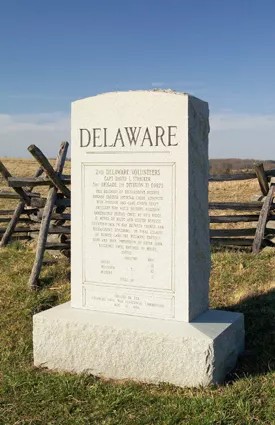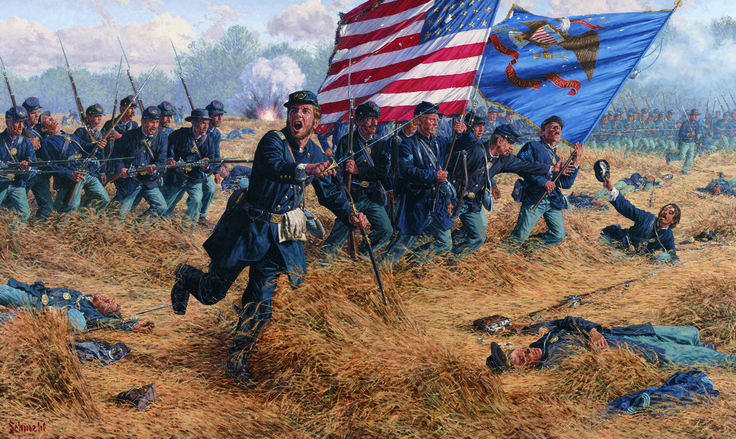The 2nd Delaware Infantry Through Robert G. Smith’s Eyes
The 2nd Delaware Infantry Through Robert G. Smith’s Eyes
Whenever I am looking for information on a regiment, I especially seek out any period written histories or histories written by veterans after the war. A Brief Account of the Services Rendered by the Second Regiment Delaware Volunteers in the War of the Rebellion written by Robert G. Smith (1909) is one of those books. Smith served in the 2nd Delaware Infantry as a 2nd Lieutenant in Company A. He was slightly wounded during the Battle of Gettysburg and was eventually discharged later that year in November. The following is a brief summary of the regiment’s service during the war based on Smith’s book.
A Modest Beginning, a Proud Record
In the early summer of 1861, Delaware answered President Lincoln’s call, and the state’s second infantry regiment began to form. As Smith notes, the regiment was “the first body of volunteer infantry in the State to form under the call for three years’ men.” The men rallied in Wilmington and across the state; some companies even reached beyond into Philadelphia and Maryland to recruit devoted Unionists.
The 2nd Delaware mustered into federal service between June and October 1861, committing to a three-year term. From the start, soldiers of the regiment faced the steady tension between civilian life and martial duty.
Early Service: Garrison Duty, Transfer to the Field
After organization, the regiment spent months on garrison duty in Baltimore, Maryland. This period, though less dramatic than pitched battle, was crucial for discipline, training, and acclimatization to military life. Smith records that these initial months were spent “without great incident,” but helped mold the regiment into a fighting unit.
In mid-1862, the 2nd Delaware was ordered to join the Army of the Potomac for the Peninsula Campaign and the subsequent Seven Days’ Battles. It would be in this crucible that the regiment earned both scars and renown.
Into the Fray: Seven Days, Antietam, Fredericksburg

2nd DELAWARE VOLUNTEERS
CAPT. DAVID L. STRICKER
3rd BRIGADE, 1st DIVISION, II CORPS
This regiment of Richardson’s reserve brigade crossed Antietam Creek. Advanced with division and came under heavy artillery fire while holding position immediately beyond crest of the ridge. It moved to right and helped repulse counterattack in gap between French and Richardson’s divisions. In final assault on Bloody Lane, the regiment crossed here and took possession of Piper Farm buildings until ordered to retire.
LOSSES
OFFICERS MEN
Killed 12
Wounded 2
Missing 2
Total 58
During the Seven Days before Richmond, the regiment was engaged in several hard fights: Savage Station, Gaines’s Mill, White Oak Swamp, Glendale, and Malvern Hill. In the aftermath, the 2nd Delaware had earned hard lessons in maneuver, command stress, and casualties.
At Antietam, the regiment took its share of fire. The battle remains one of the bloodiest single days in American history, and Delaware’s volunteers were hardly spared.
In December 1862, the regiment faced the bitter cold and carnage of Fredericksburg. Though it was not in the main storming columns, its presence before Marye’s Heights and in reserve still confronted the grim realities of war.
Smith’s account, though compact, honors the steady persistence of the regiment: “no regiment of its size in the service performed greater service by its steady discipline and endurance under fire.”
1863: Chancellorsville, Gettysburg, and Endurance

The year 1863 brought repeated tests. At Chancellorsville, the Delaware men were caught in the ebb and flow of Jackson’s flank assault and Hooker’s offensive. They held lines, withdrew in order, and endured. Their steady professionalism drew positive mention in Smith’s narrative.
But their most famous hour came at Gettysburg in July 1863. The 2nd Delaware was positioned near the center of the Union line. When senior officers fell, command fell to junior officers. Smith writes of the moment with pride:
“When their leaders were disabled the men of the regiment held together and did their full duty.” In fact, Captain Charles H. Christman took command after Colonel Baily and Lieutenant Colonel Strickler were disabled, and kept the regiment fighting. Their monument at Gettysburg now commemorates that tenacity.
After Gettysburg, the 2nd Delaware marched, refitted, and remained active in the Bristoe and Mine Run campaigns. Though perhaps overshadowed by larger units, they were consistent, dependable, and often in the thick of things.
1864 and Final Campaigns
In 1864, the Union war machine shifted into high gear under Grant’s Overland Campaign. The 2nd Delaware advanced into the Wilderness, Spotsylvania, Cold Harbor, and ultimately took part in early operations around Petersburg. Their experience was hard-earned: continual marching, skirmishing, entrenching, and sustaining losses.
At Spotsylvania Court House, in the area known as the “Mule Shoe,” the regiment was caught in fierce fighting. One account in Smith’s history reflects on the strain of those days:
“The constant strain upon both body and mind was greater than men could well endure without suffering.”
By summer 1864, the regiment’s term of service was nearing its end. On July 1, 1864, the 2nd Delaware was mustered out. Veterans and recruits were consolidated into the 1st Delaware Infantry.
Smith, in closing, remarks that the Delaware men left behind a “record which their state may proudly claim.”
Legacy and Reflections
Though compact in its published form, Smith’s Brief Account offers more than a roster or order-of-battle. It reflects a belief in duty, in small regiments doing steady work over glory. The repeated references to discipline, endurance, and quiet courage suggest that the 2nd Delaware’s character was built less on flamboyance and more on consistency under pressure.
Over its nearly three-year service, the regiment participated in many of the pivotal eastern campaigns of the war — the Peninsula, Antietam, Fredericksburg, Chancellorsville, Gettysburg, and the Overland Campaign.
In many respects, the 2nd Delaware typifies the story of many small northern state regiments: fewer thousands than the great regiments from New York or Pennsylvania, but responding with equal heart to the nation’s call. In Smith’s words, they performed “greater service by its steady discipline and endurance under fire” than many might suspect.
In placing their modest history on the record, Smith gives us not only names and dates, but a window into the lived experience — the quiet resolve of men from Wilmington, New Castle, Elkton, Philadelphia — who marched into war, held in battle, and marched home changed.
The 2nd Delaware Infantry is one of the regiments on the Research Arsenal database that we have their service record from the National Archives digitized and available for research. This includes their Regimental Descriptive Book, Consolidated Morning Reports, and Roster of Commissioned Officers, and Roster of Non-Commissioned Officers and Staff, Clothing Book for Company I, and Descriptive and Morning Reports for Company I. To browse through these records (or all of the Records Group 94 records added to our database), simply click on “Search NARA Records” on the homepage, then select “RG 94” as the call number.

